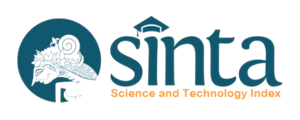THE USE OF E-RESOURCES FOR YOUNG LEARNERS ENGLISH TEACHING MATERIALS
(1) Universitas Brawijaya
(*) Corresponding Author
Abstract
Keywords
Full Text:
PDFReferences
Alwasilah, A. C. (2013). Policy on Foreign Language Education in Indonesia. International Journal of Education, 7(1), pp. 1–19, 2013. https://doi.org/10.17509/ije.v7i1.5302
Arnold, W. & Rixon, S. (2008). Materials for Young Learners. In B. Tomlinson (Ed.) English Language Learning Materials. London: Continuum International Publishing Group.
Buttler, Y. G. and Takaechi, A. (2008). Variables that Influence Elementary School Students’ English Performance in Japan. The Journal of Asia TEFL, 5(1), pp. 65-95. Retrieved on March 10, 2020, from https://pdfs.semanticscholar.org/e0fe/a8d2415f4de427e32bd34d0236b9e39b027e.pdf?_ga=2.26930237.1807811674.1582956882-572307371.1582956882
Ghosn, I. (2019). Materials for Early Language Learning. In S. Garton & F. Copland (Eds.). The Routledge Handbook of Teaching English to Young Learners (pp. 374-388). New York: Routledge.
Hamied, F. A. (2010). EFL Assessment in Indonesia: National Exams and Quality Education. In B. Spolsky & Moon, Y. Language Assessment in Asia: Local, Regional or Global? Asia TEFL (pp. 99-120). Retrieved on May 5, 2020, from https://www.researchgate.net/publication/285299294_Language_assessment_in_Asia_Local_regional_or_global
Harmer, J. (2007). The Practice of English Language Teaching (4th ed.). Malaysia: Longman.
Kain, H., & Moukarzel, D. (2018). Teachers’ and Students’ Perceptions of Online Research Skills: An Exploratory Study in South Lebanese Schools. Journal of Education and Practice, 9(24), pp. 109-117. Retrieved on March 10, 2020, from https://www.iiste.org/Journals/index.php/JEP/article/view/44039/45374
Kumar, A. A. (2019). Usage of Electronic Resources among Ophthalmologists in India, in Literacy skill development for library science professionals. IGI Global. DOI: 10.4018/978-1-5225-7125-4.ch003
Mardiani, R. (2011). The Washback Effect of English National Examination (ENE) on English Teachers’ Classroom Teaching and Students’ Learning: A Case Study at Three Secondary Schools in Bandung, East Java, Indonesia (Doctoral dissertation). Universitas Pendidikan Indonesia, Bandung, Indonesia.
Musthafa, B. (2010). Teaching English to Young Learners in Indonesia: Essential Requirements. Educationist, 4(2), 120-125. Retrieved on January 8, 2020, from http://file.upi.edu/Direktori/JURNAL/EDUCATIONIST/Vol._IV_No._2-Juli_2010/07_Bachrudin_Musthafa.pdf
Rahimi, M., & Bayat, Z. (2015). The Relationship between Online Information Seeking Anxiety and English Reading Proficiency across Gender, in Information and Technology Literacy: Concepts, Methodologies, Tools, and Applications. DOI: 10.4018/978-1-5225-3417-4.ch069
Setiasih, L. (2012). The Role of Out of School Literacy Activities in Promoting Students’ English Literacy (Doctoral Dissertation). Universitas Pendidikan Indonesia, Bandung, Indonesia.
Schuh, K. L., & Farrell, C. A. (2006). Student effort, media preference, and writing quality when using print and electronic resources in expository writing. Journal of Educational Computing Research, 35(1), pp. 61–81. https://doi.org/10.2190/QJ4N-2863-Q6L0-6360
Shyamlee, S. D., & Phil, M. (2012). Use of technology in English language teaching and learning: An analysis. In International Conference on Language, Medias and Culture, Volume 33, pp. 150-156. Retrieved on November 2, 2020, from http://www.ipedr.com/vol33/030-ICLMC2012-L10042.pdf
Swedberg, R. (2018). On the uses of exploratory research and exploratory studies in social science. Retrieved on October 23, 2020, from http://people.soc.cornell.edu/swedberg/On%20the%20Uses%20of%20Exploratory%20Research%20and%20Exploratory%20Studies%20in%20Social%20Science.pdf
Thomlinson, B. (2003). Developing Materials for Language Teaching. London: Continuum Press.
Thienthong, A., & Lian, A. (2015). The Use of Internet Resources and Applications for Language Instruction. Retrieved on November 2, 2020, from https://files.eric.ed.gov/fulltext/EJ1143399.pdf
Tseng, Y. (2014). Effects of Early Exposure to a Second Language on Its Proficiency at Later Age. Journal of Modern Education Review, 4(6), pp. 418–426. DOI: 10.15341/jmer(2155-7993)/06.04.2014/003
Ugwu, C. I., & Orsu, E. N. (2017). Challenges of utilization of online information resources by undergraduate students: Implications for information. Library Philosophy and Practice. Retrieved on October 23, 2020, from
https://digitalcommons.unl.edu/libphilprac/1668
Yanti, H., Setiawan, A., Nurhabibah, & Yannuar. (2018). Teacher’s perception about the use of E-learning/Edmodo in educational activities. IOP Conference Series: Material Science and Engineering. DOI: 10.1088/1757-899X/306/1/012055
Zein, S. (2017). The Pedagogy of Teaching English to Young Learners: Implications for Teacher Education. Indonesian Journal of English Language Teaching, 12(1), 61-77. DOI: 10.25170/ijelt.v12i1.1469
Zhang, X. (2018). Developing College EFL Writers’ Critical Thinking Skills through Online Resources: A Case Study. SAGE Open, pp 1-12. https://doi.org/10.1177/2158244018820386
DOI: https://doi.org/10.24071/llt.v24i2.3080
Refbacks
- There are currently no refbacks.
Copyright (c) 2021 Diah Royani Meisani

This work is licensed under a Creative Commons Attribution-ShareAlike 4.0 International License.
LLT Journal: A Journal on Language and Language Teaching Sinta 1 Certificate
.jpg)

This work is licensed under CC BY-SA.
Creative Commons Attribution-ShareAlike 4.0 International License


.png)

















